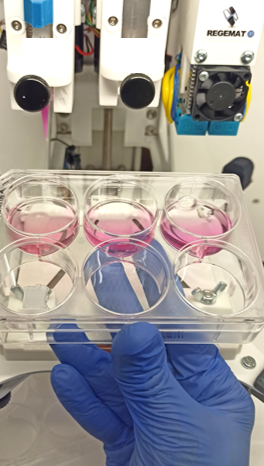Introduction
Choosing appropriate biomaterials for fabricating a bioink is a fundamental step in3D bioprinting. While a wide variety of biomaterials can be used, hydrogels have been pointed as attractive materials for bioink preparation, since they can provide a highly hydrated and permeable 3D polymeric structure with tunable mechanical and biological properties controlling cell functions.
Bioinks containing nanofibrillated cellulose and alginate have shown promising results in cartilage regeneration. Some of the advantages of these materials are their animal-free origin, minimal batch-to-batch variations and tunable mechanical properties through minimal modifications in the formulation. A protocol for preparing nanofibrillated cellulose + alginate hydrogels suitable for 3D bioprinting in REGEMAT 3D’s bioprinters is described herein. The formulation of the bioink has been optimized according to preliminary printability tests and further biocompatibility assays.
Materials
- Nanofibrillated cellulose
- Sodium alginate
- Phosphate buffered saline (1X PBS)
- CaCl2 solution
- Stirring bar
- Small glass beaker
- 50 ml conical tube
- 5 ml syringes
- 0.58 mm ID conical tips
- Pistons for syringes
- Human adipose derived-mesenchymal stem cells (hMSCs)
- Complete hMSCs culture media
- Luer-to-luer connector
- Caps for syringes
- Culture plates or dishes
- Tips for micropipettes
- Serological pipettes
Equipment required
- REG4Life bioprinter
- Biosafety cabinet (class II A)
- Waterbath
- Hot plate
- Centrifuge
- Micropipettes
- Pipetor
- CO2 cell culture incubator
Methods
Make all procedure under sterile conditions and use sterilized materials.
- Prewarm 1X PBS and human adipose derived-mesenchymal stem cells (hMSCs) complete culture media at 37 °C in a water bath.
- Prepare a 3% sodium alginate (w/v) stock solution by dissolving the sodium alginate (powder format) in prewarmed 1X PBS in a glass beaker. Please note that this procedure takes time. Use a magnetic stirrer and a hot plate and agitate at least for an ON at 37°C or until the alginate dissolves completely.
- Mix the 3% sodium alginate solution with the 2% Corbiocell nanocelulose in a 50 ml conical tube using a tissue homogeneizer. Homogeneize at 15,000 rpm for at least 5 min. The resulting solution needs to be homogeneous.
- Transfer 1.8 ml of the mixture into a 5 ml syringe. Optional: Close the syringe with caps and make a short spin with the centrifuge to remove possible bubbles.
- Mix 1.8 ml of the bioink with 2×106 ml human adipose derived-mesenchymal stem cells (hMSCs) suspended in 0.2 ml of complete hMSCs culture media. To that end, connect the 5 ml syringe containing the mixture to a 5 ml syringe containing the cell suspension through a luer-to-luer connector and push back and forth until obtaining a homogeneous bioink. In general, formulations of 1% Corbiocell nanocellulose + 1% alginate and 1.5% Corbiocell nanocellulose + 0.5% alginate yield good 3D bioprinting results. The volumes used in steps 4 and 5 are indicative and will depend on the requirements of the experiment but concentrations of approx. 1×106 hMSCs/ml bioink are recommended.
- Transfer all content into one of the 5 ml syringes, connect a 0.58 mm ID conical plastic tip and place the syringe in the nozzle of a REGEMAT 3D bioprinter.
- Switch on the REGEMAT 3D bioprinter, launch the software, select the header configuration and calibrate the nozzle. Then, load the .stl file with the desired 3D structure to print, select object and extra configurations and proceed to print in a culture multiwell plate or dish.
- Adjust printing parameters until obtaining reliable structure with the desired geometry.
- Add 50 mM CaCl2 solution to the well or the dish where the structure has been printed to proceed with the crosslinking of the bioink. Wait for 1 -5 min depending on the size of the construct.
- Remove CaCl2 solution and wash carefully with 1x PBS.
- Add complete hMSCs media and leave the plate or the dish in the cell culture incubator at 37°C and 5% CO2 for the time required according to your experiment.
| Number | Category | Product | Amount |
|---|---|---|---|
| 1 | - | Nanofibrillated cellulose | 1 |
| 2 | - | Sodium alginate | 1 |
| 3 | - | Phosphate buffered saline | 1 |
| 4 | - | CaCl2 solution | 1 |
| 5 | - | Stirring bar | 1 |
| 6 | - | Small glass beaker | 1 |
| 7 | - | 50 ml conical tubes | 1 |
| 8 | - | 5 ml syringes | 1 |
| 9 | - | 0.58 mm ID conical tips | 1 |
| 10 | - | Pistons for syringes | 1 |
| 11 | - | Human adipose derived-mesenchymal stem cells (hMSCs) | 1 |
| 12 | - | hMSCs culture media | 1 |
| 13 | - | Luer-to-luer connector | 1 |
| 14 | - | Caps for syringes | 1 |
| 15 | - | Cell culture plates | 1 |
| 16 | - | Cell culture dishes | 1 |
| 17 | - | Tips for micropipettes | 1 |

